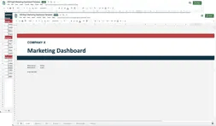Using BANT in B2B SaaS sales
BANT is not completely dead. The digital journey of the modern buyer, should make you think a little bit different about the 4 letters though...

Your marketing team’s success and the outcomes of your campaigns depend on your ability to track and measure performance, and make the necessary changes.
How does your team, yourself and leadership get a view of your marketing team’s progress at a quick glance? How do you get your team to remain focused on relevant KPIs, hold themselves accountable, and stay motivated?
Creating a marketing dashboard will allow you to easily and efficiently track progress, make appropriate decisions, hold your team accountable, and even motivate them to improve and succeed.
The answer may seem simple, but it can often be challenging to get started. Here’s everything you need to know about marketing dashboards––from getting it set up to keeping best practices, and even a free downloadable template you can take with you.
If like many others, you own a smartwatch, Apple Watch, or fitness tracker; you will instantly understand the benefits of a quick glance.
With a small glimpse, you can see how many steps you took, who sent you an email –enabling you to easily track progress and make decisions. Did you already meet your fitness goal? How many more steps do you have to take? Do you need to read and respond to that email right now? Or maybe it's not urgent.
You can always dive deeper into your fitness goals or whip out your phone to read the full email, but a quick glance enables you to act on these things and decide whether or not it's worth looking into.
Just like a smartwatch, a dashboard is meant to give you a quick glance at the progress of your marketing team. It should be easy to read and easy to understand, so you can gain visibility into how your marketing team is performing against their KPIs. This is extremely beneficial to align not only your marketing team, but also leadership.
It's important to note that not everyone will have access to Google Analytics to track search impressions, or know where to find Organic Search MQLs –the dashboard allows your entire team to gain a single-source-of-truth for all marketing KPIs, without the hassle and time-consuming task of digging through heaven and hell to get the information that they need.
Motivation is key to a successfully operating marketing team. The dashboard also allows others to feel that there is a goal to be reached, so that they can feel motivated when they succeed when they crush their KPI, and celebrate the wins with the team.
It is equally important to let your team know that this is not meant to be a competitive scorecard to put others down, or make them feel bad. Rather, it should serve as forward looking and a gentle reminder to keep the pace and visibly display progress for each KPI
Finally, it serves as a discussion point in your next team meeting –to help make sure the team is aligned cross-functionally on their goal, and what they need help with from each other to achieve them. It also serves as a good reporting tool for the board of directors at the end of the quarter to see how marketing has been performing.
It is easy to get lost in automation. I personally have found it confusing lately to know ‘which light switch does what’ after I became a frequent user of (and now am nearly spoiled by) “Hey Siri, turn on my bedroom lamp.” Similar to this, automation can cause your team to forget about their KPIs – to think, “Oh don’t worry, It’s tracking automatically so it must be correct,” or worse, “KPIs? What KPIs? I didn’t realize we were focusing on them.”
Manual entry forces the owner of the KPI to keep it top of mind. Having them fill it out at the same time each week will create a habit and enable them to always pay attention to the numbers. Consider setting a calendar block for all the relevant owners to avoid excuses of not having enough time.
This is not to say that automation isn’t valued nor is it beneficial in the long run –manual input is not forever. Once you’ve verified over a couple months that your dashboard is running smoothly, without any errors in numbers or source, feel free to automate! I can assure you that you will find that in the first couple weeks there will be many mistakes in finding the correct source, correct number, or correct definition –so start manual!
Don’t expect this all to be nailed down in a week. It is easy to find yourself changing the dashboard within the first couple weeks –which is another reason why you shouldn’t immediately automate it. One will often find that maybe the KPI number was too trivial, perhaps a number should have been absolute vs. a percentage, a definition wasn’t aligned with the feed they’re getting the numbers from, or nothing was being filled in for weeks.
You will definitely see errors in the numbers and this is good. It’s an opportunity to revise and review whether these are the right KPIs to track and the right goals to set. Maybe the dashboard was set up incorrectly, or the numbers don’t match expectations, or maybe there was a break in automation between what is being reported and what is actually happening.
It takes time to create a good functioning dashboard. There is no better way to create, maintain and sustain a successful dashboard than by following best practice principles. Click here to read about 5 Principles To Build A SaaS Marketing Dashboard.
Now that you have the foundation, let's dive a little deeper into what you can expect to see in a dashboard for leadership and a dashboard for marketing functions––complete with a free SaaS marketing dashboard template download so you can get started.
A great executive dashboard will focus on meaningful results vs. actions. It’s very easy to want to report on all the cool things marketing has done, but ask yourself “what would the CEO or BoD want to see?” Be picky –It’s okay. The dashboard is not an all-you-can-eat buffet of information –leadership doesn't have time for all of that. They want that quick glance.
Consider starting with funnel stages as an all up view of marketing performance. Generally this should suffice, but it may also be beneficial to add relevant inbound and outbound marketing KPIs that often come up for discussion in your meetings with leadership.
It is worth asking them directly what they would like to see or what is meaningful for them to keep track of. Most importantly, don’t forget that you have to factor in what is important to you. If you are owning the results, it's imperative that you feel that there are metrics you are proud to stand behind.
Finally, consider what metrics you would want to see to help you make strategic decisions; to help choose certain focus areas for monthly initiatives or to find opportunities in the team for improvement.
Still puzzled about which KPIs to track? Find out more on 10 Marketing KPIs Every B2B SaaS Company Should Track.
For larger teams with a more sophisticated and defined marketing function, consider getting each member to define their KPIs and have them start thinking about what is meaningful for them, and for leadership as it relates to their role. This will not only help force them to focus on nailing down metrics that are relevant so that the list isn’t 60 rows long, but also keep them accountable and motivated of the KPIs that they own.
Ask probing questions like:
One important tip is to ensure that the team has properly defined the KPI and truly owns it. In the downloadable template below you will find a column for definition and owner. Take the time to properly define it with your team, and have them create their own definition to help keep the onus on them :-)
It's easy to get caught up in numbers and metrics –wanting to see the results every day. On the other hand, it's equally easy to focus on the big picture and track the data monthly. While there is no right or wrong answer, I believe that weekly reporting strikes the perfect balance between being granular without taking too much time, while also being actionable from its frequency.
Click below to download your free marketing dashboard template so you can start tracking your team’s progress and improve your marketing team.

Get on your way to creating a marketing dashboard that helps you make appropriate decisions, hold your team accountable, and motivate them to succeed.
Fadi co-founded Kalungi in 2018 with Stijn Hendrikse. He has over 20 years of experience in marketing and building businesses. He is a certified HubSpot Champion User.
BANT is not completely dead. The digital journey of the modern buyer, should make you think a little bit different about the 4 letters though...
Learn how to calculate the quality of leads entering your b2b saas marketing funnel, and what that means for your revenue goals. Download our free...
Struggling to decide between hiring a B2B SaaS marketing agency or building an in-house team? Discover the pros, cons, and costs to make the right...
Be the first to know about new B2B SaaS Marketing insights to build or refine your marketing function with the tools and knowledge of today’s industry.